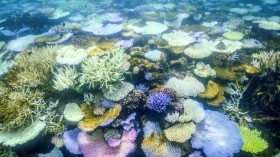No, scientists won't be asking you to age Mars off the top of your head, but they will be asking for your help in work that could settle how exactly old the Red Planet's current surface is once and for all.
That's at least according to the folks behind the Planet Four: Craters citizen science project, which asks the visitors of specially designed website to highlight and describe craters depicted in countless photographs of the Martian surface. Volunteers can even assess the interface of the site itself, helping designers determine how to make Martian surface assessment quick and easy for just about anyone.
"Planet Four: Craters is exciting because it not only allows members of the public to directly contribute to planetary research in a very real way, but also lets them tell us what they like and dislike about the interface, so that we can improve their experience in the future," James Sprinks, a researcher at The University of Nottingham and the project lead for Planet Four: Craters, reiterated in a statement.
According to Sprinks, the project is heavily dependent on armchair scientists around the world logging into the project's site to start exploring.
After a short tutorial on how to use one of several different interface designs, a visitor can get straight to analyzing the latest satellite imagery of the Martian surface provided by the HiRISE (High Resolution Imaging Science Experiment) and CTX (Context) cameras on board NASA's Mars Reconnaissance Orbiter.
"We need your help to locate these craters and record their size. They are not difficult to find - sometimes there can be hundreds within one image," Sprinks and his team explain on the site. "There simply aren't enough scientists to do this work, which is where you come in... By counting how many craters are on different surfaces (for example a lava flow or an ancient sea bed), we can figure out when those features were formed."
So how they heck does that work? By assuming that a fresh surface will have zero craters, and by estimating how many impacts the Red Planet must have seen at any one time, researchers can then determine how old it's current surface really is - an important clue about Mars' mysterious past.
People are also just much better than even more most advanced computers at analyzing images for key features, as the human brain can process a min-boggling amount of visual information at once.
Sprinks added that "with public participation in this research, not only can anyone actively contribute to science, but hopefully they may learn a little bit about the planet Mars, and get to see amazing images of the surface in the process."
For more great nature science stories and general news, please visit our sister site, Headlines and Global News (HNGN).
- follow Brian on Twitter @BS_ButNoBS
© 2024 NatureWorldNews.com All rights reserved. Do not reproduce without permission.

![Microplastics Escape Body's Gut to 'Infiltrate' the Brain, Kidneys and Liver [Study]](https://1471793142.rsc.cdn77.org/data/thumbs/full/70195/280/157/50/40/microplastics-escape-bodys-gut-to-infiltrate-the-brain-kidneys-and-liver-study.jpg)



